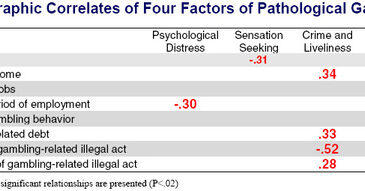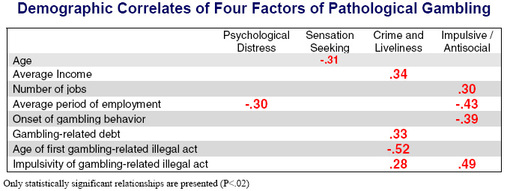Factor analysis allows us to break down a complex construct into its principal components. For example, through factor analysis, we might find that the construct of depression is made up of four factors: dysphoria, anhedonia, vegetative symptoms, and suicidality. By determining the principal components of a psychiatric disorder, we can better understand how it is similar to or different from other disorders.
Steel and Blaszczynski (1996) used factor analysis to deconstruct pathological gambling disorder into its principal psychological components. They used a sample of 115 subjects (101 males / 14 females) drawn from a psychiatric hospital (n=80) and from Gamblers Anonymous (n=35). All subjects from the hospital met DSM-III criteria for pathological gambling.
The authors administered an extensive battery of psychological screens. Some of the dimensions measured were depression, neuroticism, extroversion, boredom proneness, and impulsiveness. In addition, the battery included a measure of criminal behavior and a screen for various personality disorders.
The analysis produced four principal components of pathological gambling: psychological distress, sensation seeking, crime and liveliness, and impulsive/antisocial behavior. The table below demonstrates how these four factors correlate with various demographic variables.
Several interesting relationships appear. First, among the sample, age is inversely related to sensation seeking. That is, higher ages are associated with lower levels of sensation seeking. Perhaps this explains why bungee jumping and sky surfing are primarily sports of the young. A parallel finding reveals an inverse relationship between age of onset of gambling behavior and level of impulsivity and antisocial behavior. That is, as the age of onset increases, the level of impulsivity and anti-social behavior decreases. Lastly, there is a positive relationship between average income and crime and liveliness among pathological gamblers. This finding runs counter to the conventional wisdom that low incomes are necessarily associated with higher levels of crime.
It is possible that these relationships are not unique to pathological gamblers and that similar results would be found among a community sample. Also, factor analysis is a complex, multi-stage technique that can produce several solutions to a single problem. It is possible that if provided with the authors’ dataset, another statistician might come up with very different findings. The results of any factor analysis should not be viewed as a final, ultimate answer; rather, these data reduction strategies provide a jumping-off point for further research.
References
Steel, Z. & Blaszczynski, A. (1996). The factorial structure of pathological gambling. Journal of Gambling Studies, 12, 3-20.





